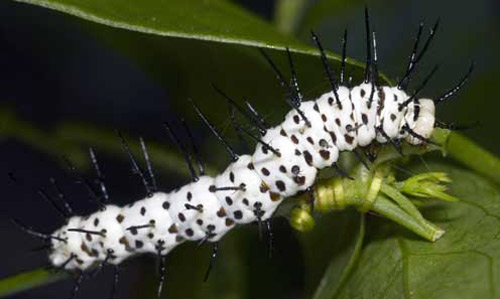Not the four-legged variety found in Africa. The zebras I’ve been seeing are garden-variety critters. Their official name is Heliconius charitonius, but most people know them as zebra longwings. They are butterflies, slender-winged bedazzlers with just a hint of red on their otherwise black and whitish-yellow wings.
Instead of grazing on grass like their horse-like namesakes, these fluttering beauties flit around the yard sipping nectar and feeding on pollen gathered from flowers. Found throughout Florida in hardwood forests, thickets and gardens, this neotropical butterfly is not only distinctive looking, it holds a special distinction. In 1996 it was named the official state butterfly of Florida.
In my yard, there has been a sudden population explosion of this easy-to-identify flier. I’m probably seeing so many zebras because of all the passion flower vines growing wild on our property.
 |
| The Florida passionvine flower |
Passionvine is the the host plant on which zebra longwings lay their eggs. In the right weather, it takes only about three weeks for the 15 yellow eggs each butterfly lays on a passionvine leaf to develop into a butterfly.
 |
| Zebra longwing laying eggs on passionvine leaf |
Of course, before it can become a butterfly, an egg must first develop into a caterpillar and the white and black spotted, black-spined zebra longwing larvae have another distinction. Their bodies taste terrible and are poisonous to predators. The larvae get this extra protection from the leaves of their host plant.
When zebra longwing caterpillars eat the leaves of their host plant, toxins in the passionvine leaves enter their bodies. While the toxins don’t harm the butterfly larvae, they do major damage to unwitting predators that mistakenly bite into them. Predators soon learn to stay away from the foul tasting, poisonous insects resulting in a much higher developmental success rate than many other species experience.
 |
| Zebra longwing with curled proboscis |
Once mature, zebra longwings, which can live up to six months, are busy finding food. Of course, not all flowers are equal. Just as people prefer one type of bloom over another, the zebra longwing has preferences, too. I’ve seen them completely ignore angel trumpet flowers, yet gather en masse around the purple and white blossoms of golden dewdrop growing right next to the angel trumpet. Lately they’ve also been paying special attention to the purple porterweed flowers and the red blossoms on the bottlebrush trees.
 |
| Zebras are attracted to sticky red bottlebrush blooms |
While many other butterflies flit about with manic energy that makes observation challenging, watching zebra longwings is easy. Zebras are seldom in a rush, often pausing for a moment or two at each flower before moving on to the next bloom at what seems to be a confident, leisurely pace. Their calm flight pattern makes zebra longwings easy subjects to photograph as well as to observe.
One of my most exciting zebra longwing observations took place several years ago at dusk when I was walking through a wooded part of our property. My path just happened to take me by a slender tree limb where I noticed dozens of these black-and-white beauties clustered together on a branch. Although I didn’t realize it at the time, the butterflies were settling in for their nightly communal rest.
 |
| Zebras settling in with their brethren for their nightly slumber party |
Zebra longwings are extremely social creatures. Not only do they seem to enjoy the companionship of their brethren during daylight hours when feeding, at nighttime they like to sleep next to each other, too. Every night dozens of butterflies come together to roost on a tree branch in a protected part of a woods. They return to the same spot night after night. Zebra longwings epitomize the term “social butterfly.”
It has been a long time since I encountered a butterfly slumber party, and I look forward to chancing upon one again some evening. Until then, however, I’m enjoying my daylight observations. Seeing the flight of dozens of zebra longwings fluttering around the flowers in my garden may not be as exciting as observing a herd of real zebras in the wild but it’s a darn close second.
 |
| There are real zebras in Florida too! Read about them on my post Exotic animals A to Z |



No comments:
Post a Comment